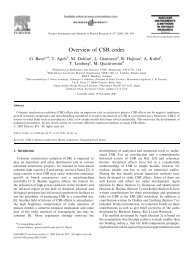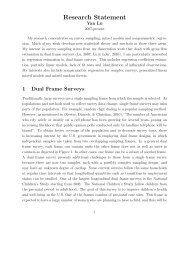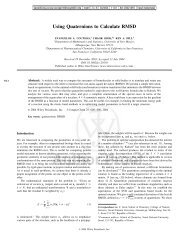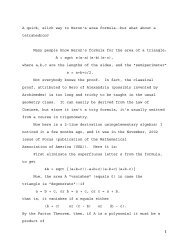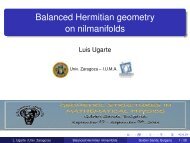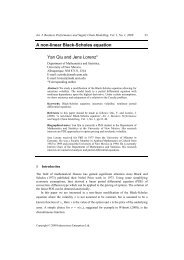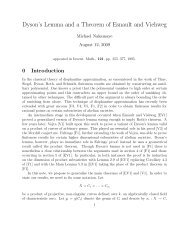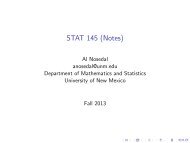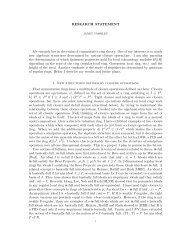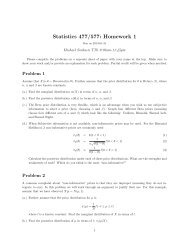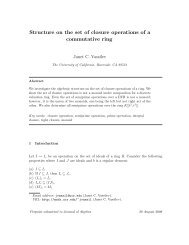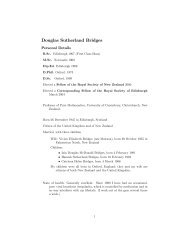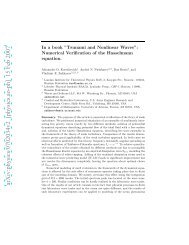OEO Office of Equal Opportunity - Department of Mathematics and ...
OEO Office of Equal Opportunity - Department of Mathematics and ...
OEO Office of Equal Opportunity - Department of Mathematics and ...
Create successful ePaper yourself
Turn your PDF publications into a flip-book with our unique Google optimized e-Paper software.
172 ARTS AND SCIENCES<br />
ENGL 219, 220 or 290 is required as an A&S Group<br />
Requirement.<br />
Note that EPS 319L (Introductory Field Geology) is taught<br />
as a 3-week course immediately after the completion <strong>of</strong> the<br />
Spring semester.<br />
Students completing the B.S. program will fulfill the requirements<br />
for a distributed minor, although an alternative minor<br />
or second major may be selected.<br />
For the degree <strong>of</strong> Bachelor <strong>of</strong> Arts: EPS required courses:<br />
101, 105L (or ENVS 101 <strong>and</strong> 102L), 201L, 301, 302L, 303L<br />
304L, 307L, 310L (or 319L), 401, 490 <strong>and</strong> 6 additional hours<br />
in Earth <strong>and</strong> Planetary Sciences above 299 (excluding 491-<br />
492, 493 <strong>and</strong> 495). Total credits for the Earth <strong>and</strong> Planetary<br />
Sciences sequence=37.<br />
Non-Earth <strong>and</strong> Planetary Sciences required courses: CHEM<br />
121L <strong>and</strong> either PHYC 151 or 160; <strong>and</strong> 9 additional hours<br />
from Chemistry or Physics above the required levels, or from<br />
MATH 162 or above, BIOL 123/124L or higher, or ASTR 270<br />
or above, or (with permission from the EPS Undergraduate<br />
Committee) from selected Anthropology, Engineering or<br />
Geography courses. Total Credits <strong>of</strong> Supporting Science=16.<br />
EPS 319L (Introductory Field Geology) is taught as a 3-week<br />
course immediately after completion <strong>of</strong> the Spring semester.<br />
Minor Study Requirements<br />
The minor in Earth <strong>and</strong> Planetary Sciences will consist <strong>of</strong><br />
20 credit hours, <strong>of</strong> which 12 must be above the 299 level<br />
(excluding 401, 493 <strong>and</strong> 495). No more than 3 credit hours<br />
<strong>of</strong> problems may be applied to the Earth <strong>and</strong> Planetary<br />
Sciences minor (491–492).<br />
<strong>Department</strong>al Honors<br />
Students seeking honors in Earth <strong>and</strong> Planetary Sciences<br />
should consult with the department honors advisor no later<br />
than two full semesters prior to graduation. EPS 493 <strong>and</strong><br />
495 are required, as is a written senior thesis that will be<br />
orally defended.<br />
Graduate Program<br />
Graduate Advisors<br />
Grant Meyer<br />
Jane Selverstone<br />
Application Deadlines<br />
Fall semester: January 31 (with financial aid)<br />
April 1: (without financial aid)<br />
Spring semester: November 1<br />
Degrees Offered<br />
M.S. in Earth <strong>and</strong> Planetary Sciences<br />
Ph.D. in Earth <strong>and</strong> Planetary Sciences<br />
The <strong>Department</strong> <strong>of</strong> Earth & Planetary Sciences <strong>of</strong>fers the<br />
M.S. <strong>and</strong> Ph.D. degrees. In addition to the application form<br />
<strong>and</strong> fee <strong>and</strong> <strong>of</strong>ficial transcripts for all college study required<br />
by the <strong>Office</strong> <strong>of</strong> Graduate Studies, the <strong>Department</strong> requires<br />
three letters <strong>of</strong> recommendation, a letter <strong>of</strong> intent, un<strong>of</strong>ficial<br />
transcript copies, <strong>and</strong> general GRE scores for admission consideration.<br />
Application instructions <strong>and</strong> forms for admission,<br />
financial aid, <strong>and</strong> letters <strong>of</strong> recommendation are available<br />
from the <strong>Department</strong> <strong>of</strong> Earth & Planetary Sciences via our<br />
Web site: http://epswww.unm.edu.<br />
The <strong>Department</strong> <strong>of</strong> Earth & Planetary Sciences has several<br />
graduate “tracks.” For the general geoscience track, qualified<br />
students must have a background equivalent to the requirements<br />
for the B.S. degree in Earth & Planetary Sciences at<br />
the University <strong>of</strong> New Mexico. Students holding degrees in<br />
other areas may also be admitted with the underst<strong>and</strong>ing<br />
that they may be required to remove deficiencies in Earth<br />
& Planetary Sciences courses <strong>and</strong> the supporting sciences.<br />
Earth & Planetary Sciences courses required for the B.S.<br />
degree are mineralogy, petrology, structural geology, stratigraphy/sedimentology<br />
<strong>and</strong> introductory field geology. Work<br />
in the supporting sciences for the B.S. degree includes<br />
mathematics through calculus (MATH 264 or equivalent),<br />
one semester <strong>of</strong> statistics <strong>and</strong> computer science, one year<br />
<strong>of</strong> general chemistry <strong>and</strong> one year <strong>of</strong> calculus based physics<br />
(PHYC 161 or 262 or equivalent). For other graduate tracks,<br />
required background courses in geosciences <strong>and</strong> in the<br />
supporting sciences differ; please consult the <strong>Department</strong><br />
<strong>of</strong> Earth & Planetary Sciences. Under certain circumstances<br />
direct admission to the Ph.D. program from a B.S. degree<br />
may be possible.<br />
General requirements for the M.S. <strong>and</strong> Ph.D. degrees are<br />
stated in the earlier pages <strong>of</strong> this catalog. Each c<strong>and</strong>idate will<br />
meet with a temporary advisor, identified by the Chairperson,<br />
during the first week or so <strong>of</strong> the first semester <strong>of</strong> enrollment.<br />
The results <strong>of</strong> this interview will determine in part the<br />
student’s ensuing schedule. M.S. c<strong>and</strong>idates are required to<br />
pass an examination involving the preparation <strong>and</strong> defense <strong>of</strong><br />
a thesis proposal during the second semester <strong>of</strong> enrollment.<br />
Ph.D. c<strong>and</strong>idates are required to pass a Comprehensive<br />
Examination, during the third semester <strong>of</strong> post-M.S. enrollment,<br />
involving the preparation <strong>and</strong> defense <strong>of</strong> two dissertation<br />
proposals.<br />
Earth <strong>and</strong> Planetary Sciences<br />
(EPS)<br />
101. How the Earth Works—An Introduction to Geology.<br />
(3)<br />
A fascinating tour <strong>of</strong> our active planet. Explore earth materials<br />
(rocks <strong>and</strong> minerals), the continents’ motions <strong>and</strong> related origins<br />
<strong>of</strong> earthquakes, volcanoes, mountain building, oceans,<br />
l<strong>and</strong>scapes, natural energy <strong>and</strong> economic resources, global<br />
warming <strong>and</strong> other topics. Students are encouraged but not<br />
required to enroll concurrently in 105L. Meets New Mexico<br />
Lower Division General Education Common Core Curriculum<br />
Area III: Science (NMCCN 1114).<br />
105L. Physical Geology Laboratory. (1)<br />
Minerals, rocks <strong>and</strong> topographic <strong>and</strong> geologic maps; field<br />
trips. Meets New Mexico Lower Division General Education<br />
Common Core Curriculum Area III: Science (NMCCN 1114).<br />
Pre- or corequisite: 101. {Fall, Spring}<br />
106. Evolution <strong>and</strong> Age <strong>of</strong> the Earth. (2) Sharp<br />
The scientific method applied to determination <strong>of</strong> the age<br />
<strong>of</strong> the earth, origin <strong>of</strong> life, evolution <strong>of</strong> the Earth <strong>and</strong> <strong>of</strong> life,<br />
extinction, life on other worlds <strong>and</strong> related topics. Intended for<br />
non-science majors.<br />
110. Topics in the Earth Sciences. (1-3 to a maximum<br />
<strong>of</strong> 3) ∆<br />
Eight- to 16-week courses on selected topics relating directly<br />
to the human experience, e.g., Volcanoes, Extinctions,<br />
Weather, Earthquakes, New Mexico’s Water, Soils, Nuclear<br />
Hazards, Geomagnetism, Albuquerque Field Geology <strong>and</strong><br />
the Geology <strong>of</strong> Everyday Life. {Fall, Spring}<br />
115. Geological Disasters. (3)<br />
Causes <strong>and</strong> effects <strong>of</strong> disastrous geological events, including<br />
earthquakes, volcanic eruptions, tsunamis, l<strong>and</strong>slides<br />
<strong>and</strong> floods.<br />
201L. Earth History. (4) Elrick, Smith<br />
Origin <strong>and</strong> history <strong>of</strong> the Earth including age <strong>of</strong> the planet<br />
<strong>and</strong> dating <strong>of</strong> rocks, changing configurations <strong>of</strong> oceans <strong>and</strong><br />
continents as a result <strong>of</strong> plate tectonics, records <strong>of</strong> climate<br />
change, history <strong>of</strong> formation <strong>and</strong> erosion <strong>of</strong> mountain chains,<br />
origin <strong>and</strong> evolution <strong>of</strong> life <strong>and</strong> causes <strong>of</strong> extinction. Required<br />
field trip <strong>and</strong> lab exercises permit underst<strong>and</strong>ing <strong>of</strong> how Earth<br />
UNM CATALOG 2006–2007 Symbols, page 611.



